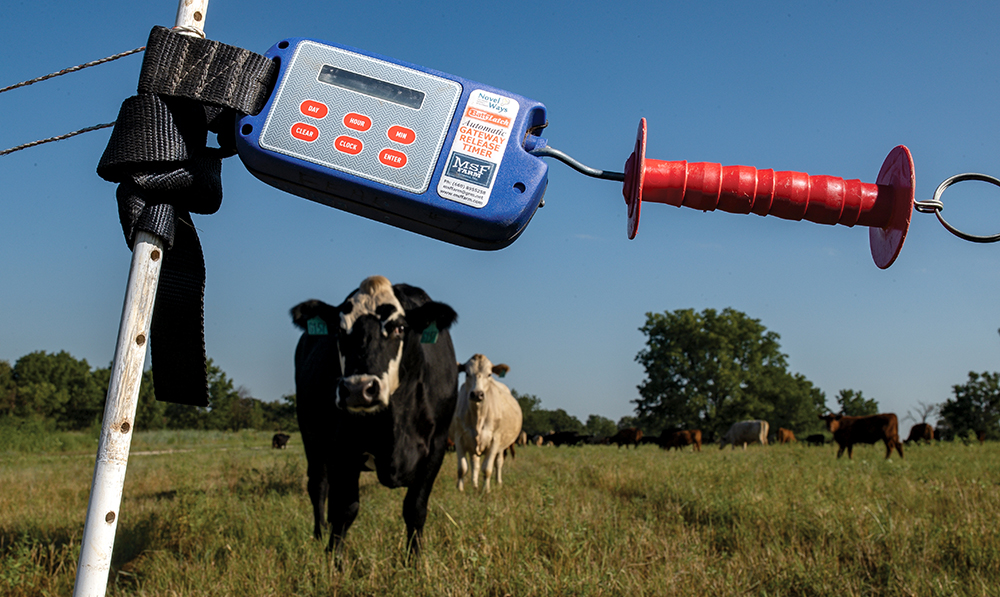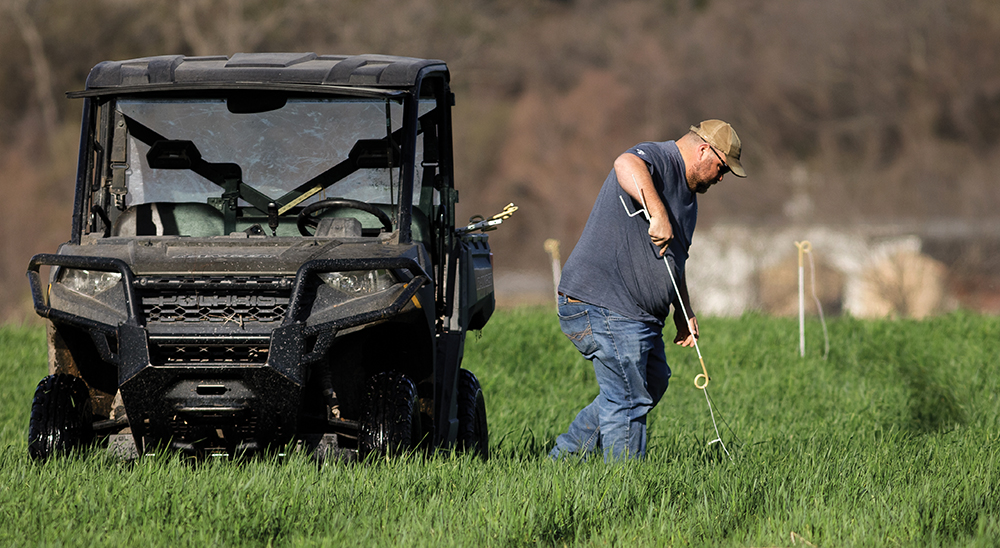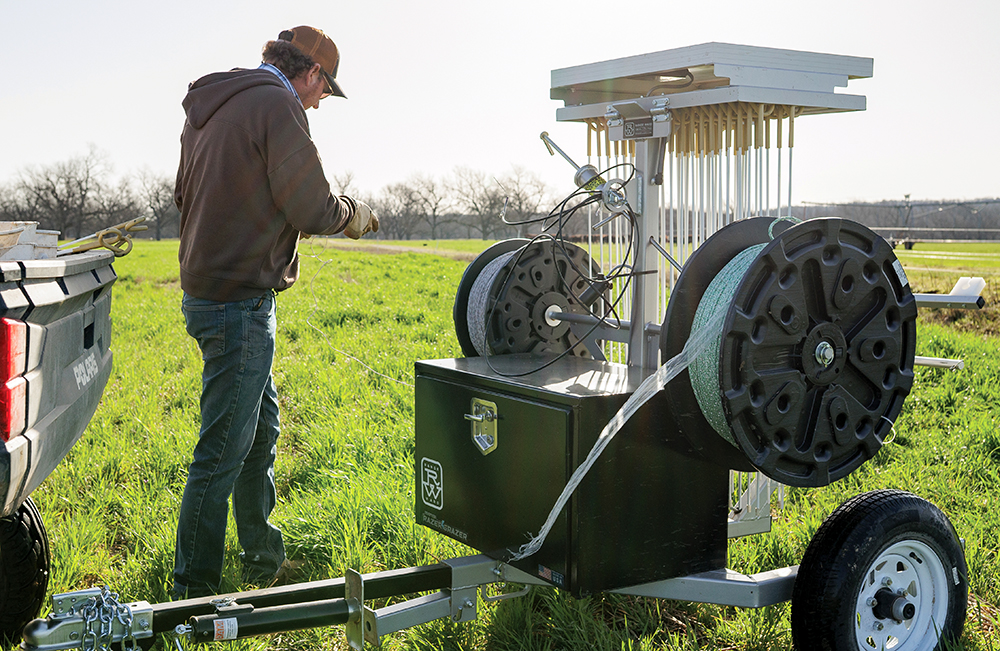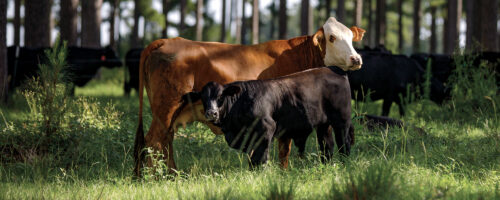Tools of the Trade
Ranch Manager Kevin Pierce shares his experience with three grazing tools being used on Noble's Red River Ranch.
Kevin Pierce emerges from his office on Noble’s Red River Ranch with a small, blue device in his hand. Pierce, the ranch manager at Red River, eagerly sets up a demonstration of how a Batt-Latch works. It’s a solar-charged gate release timer Pierce started using a couple of months earlier at a time when he was moving one of the cattle herds four times a day.
He sets the time on the device, connects the spring gate to the porch railing and the strap of the timer to a step-in post in the ground and steps back. Within a few moments, the Batt-Latch lets out a few warning beeps and releases the spring gate, which ricochets toward the porch railing with surprising speed.
This portable device is one of several new-to-Noble tools Pierce is trying out to see how each may enhance grazing management efficiency. These grazing tools are not explicitly designed for regenerative grazing management. But if you’re in the market for a nifty tool that can ease one fencing challenge or another, Pierce has some insight into Batt-Latches, Tumblewheels and the Razer Grazer trailer.

Complementing the Ranch’s Context
Situated along the Red River on the border with Texas, Red River Ranch is Noble’s southernmost ranch. The ranch’s gently rolling land is predominantly introduced pastures and grazed cropland that was managed conventionally until 2021, when Noble converted to regenerative management on all of its ranches. The long-term objective is to restore native grasses on the ranch through regenerative management.
Red River Ranch benefits from existing electrified exterior fences, which makes several paddocks – those on flat ground without trees – well suited for Gallagher’s Tumblewheels, an innovative replacement for traditional temporary fenceposts.
Each Tumblewheel’s six aluminum spokes roll across pastures when strung through the middle with a taut hot wire. They’ve become a great option for Pierce to section off grazing paddocks.
“They worked great there because the fences are not too long; they’re pretty square; and there aren’t a lot of obstacles,” says Pierce. He says he found that a quarter-mile stretch of temporary fence is too long to use Tumblewheels, but they work well for fences up to around 700 to 800 feet. To expand the grazing paddock for the herd of cows, Pierce releases the fence-line handle from the hot wire and walks forward. The Tumblewheels holding the wire follow behind him, turning spoke over spoke. He reclips the handle, walks to the other side of the paddock and repeats his forward walk to even out the fence line.
Pierce says they are easy to use when setting up interior temporary fence lines. But getting Tumbleweels to and from pastures requires a vehicle with enough capacity.
“They don’t stack well, so hauling them to the field can be cumbersome,” Pierce says, motioning to the utility vehicle with a small cargo area he typically uses. A truck bed or small trailer would be better suited to carry enough to make a fence line.
The Tumblewheels work well in most areas of Red River Ranch with existing electrified perimeter fence. However, there are times when a different new-to-Noble tool comes in handy.

Pivoting in an Emergency
When building an interior fence at Red River Ranch, Pierce and his team can almost always tie off to an existing electrified fence. However, he has found the all-in-one Razer Grazer to be a useful tool when circumstances change.
“About a month ago, the river flooded the bottom of the pasture down there,” Pierce says, pointing out the southern portion of the ranch. “It took out some of the fence, and some fence chargers were underwater, so we had to cut power to them. We took the Razer Grazer down there and set up temporary fences. We made some really long fences — about a mile long — which is when having the automatic reel winder on there is really nice.”
Building electric fence when the power goes out or where electricity doesn’t exist is the biggest benefit of the Razer Grazer. The portable, solar-powered trailer meant Pierce could stick to his grazing plan even when nature intervened.
To use the Razer Grazer trailer, Pierce sets the fence with an end post or ties off to a tree. Then he drives the fence line in the UTV as the wire unspools off the trailer behind him. Once the fence is up, he unhooks the trailer, sets the ground wire and flips on the charger. Then he returns to his fence line and adds posts.
The trailer has just about everything a rancher needs to build a fence: 80 pigtail, step-in posts; a 12-volt powered reel; and a 50-watt solar panel powering a 12-volt deep-cycle battery, which energizes fences with up to three joules.
The Red River Ranch team typically wouldn’t have a strong need for such an intricate fencing tool, but Pierce was happy to have it during the flood and acknowledges the value it could provide on other ranches.
“I could see how at some ranches — folks with permanent barbed-wire fences, not hot wire — this would be extremely beneficial,” says Pierce, thinking of his colleagues at Noble’s Oswalt Ranch. Though he’s not sure how the trailer would handle the rougher terrain of those ranches. “Maybe there would be different learning curves to using it on rocky or hilly land,” he says.

Man Versus Machine
When asked if he would purchase these specialized fencing tools for his own ranch, Pierce has mixed feelings. On one hand, he’s built fences manually for decades, without the need for these tools. But he’s also getting older.
“It may take a bit more time to build a fence with the Razer Grazer, but it makes it easier in my opinion. Especially for the reeling-up part,” says Pierce.
“A young person may think it’s faster to build a fence manually. But at my age, it saves my arms a bit from cramping.”
Despite being troublesome to stack and haul, the Tumblewheels are a time-saver when Pierce is moving cattle through a pasture in smaller paddocks over several days, as he only has to build the fence once. However, it’s not a tool Pierce thinks would work everywhere.
“The Tumblewheels work really well in smaller areas if the grass is not too tall and there aren’t any ground obstacles. I think producers with smaller acres could find this to be a great tool,” says Pierce.
Perhaps the handiest tool for adaptive multi-paddock grazing is the Batt-Latch gate release. Pierce tried it for the first time when he was under a strict grazing protocol for the Metrics, Management, & Monitoring (3M) Project, one of Noble’s research studies.
“We were moving cattle four times a day: 7 a.m., 11 a.m., 3 p.m. and 7 p.m. We set this up so it would open the gate, and the cows could move themselves at 7 p.m.,” says Pierce. “They have a solar panel on them, so they charge on their own. As far as I know, we’ve never changed the battery on this one.”
Leveraging new technology to ease the workload on the ranch isn’t new. Ranchers have improvised and found workarounds for generations. In Pierce’s eyes, none of these tools are essential. Sometimes he’d just prefer to build a fence the old-fashioned way, the way he’s done for decades, developing efficiency through experience. But, he admits, it’s nice to plug in these resources when they make sense for a ranch’s context and budget.



Comment